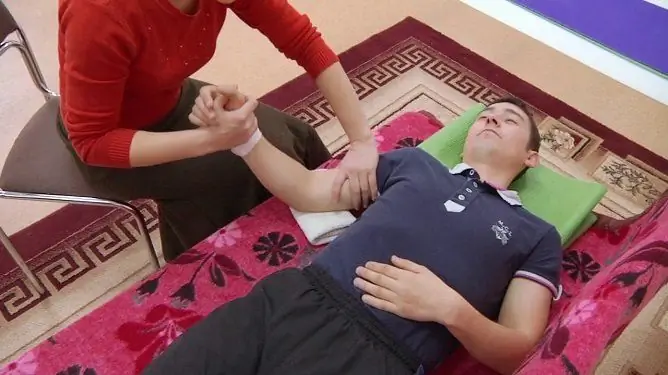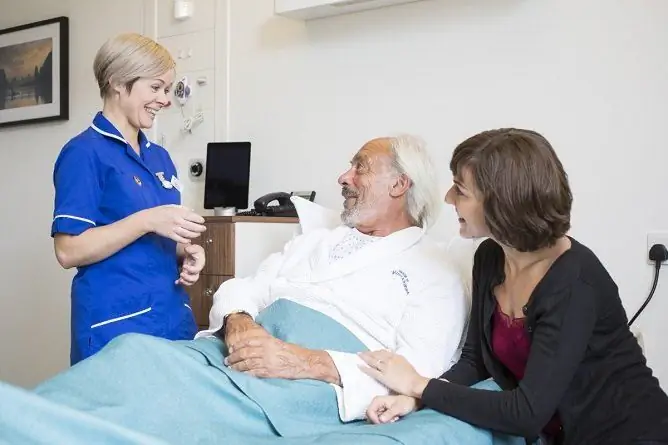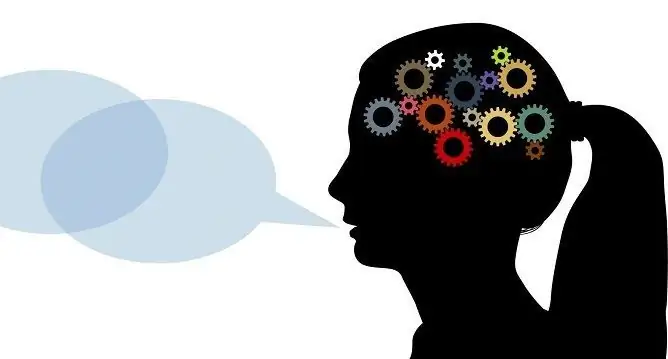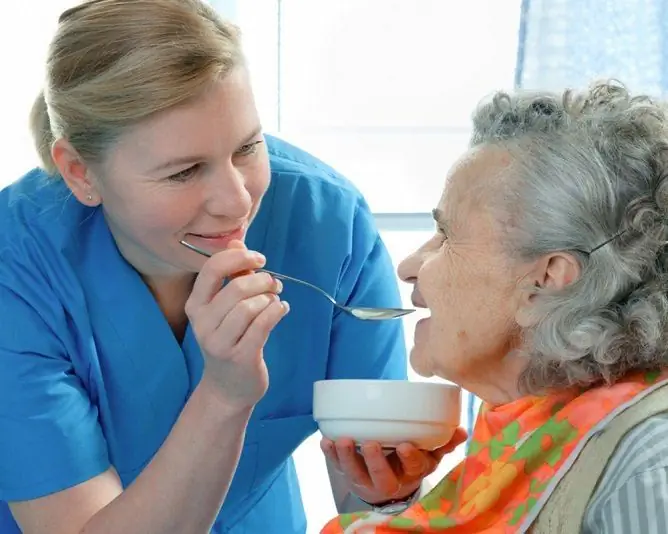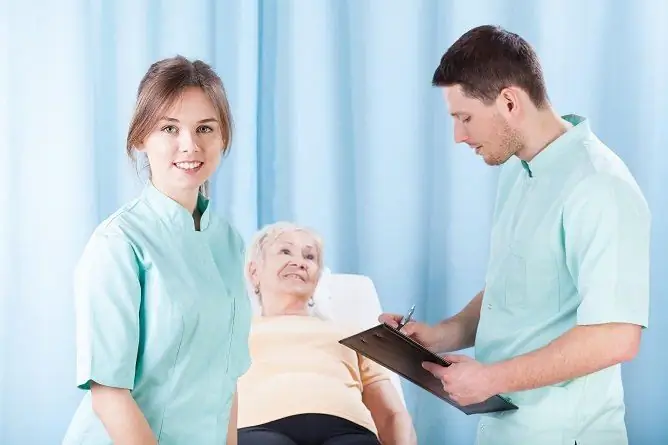- Author Rachel Wainwright [email protected].
- Public 2023-12-15 07:39.
- Last modified 2025-11-02 20:14.
Organization of proper nutrition after a stroke at home
The content of the article:
- Principles of food selection after a stroke
- Meal mode
- What can you eat after a stroke
- What should be limited in the diet
- Diet after a stroke: table 10 according to Pevzner
- Video
Post-stroke nutrition is an important part of rehabilitation interventions that complement mainstream treatment. The concept of rehabilitation and lifestyle correction, in addition to diet, includes exercise, rejection of bad habits, normalization of body weight. In the absence of complications, these interventions usually begin about three to six days after the attack.
Principles of food selection after a stroke
The correct diet after a stroke should be made under the guidance of a doctor or dietitian. The specialist will tell you what you can eat and drink after a stroke, which dishes can worsen the patient's condition, and which, on the contrary, will be useful, product compatibility is also important. An approximate menu, taking into account individual indications, is usually developed for a week, then the patient or his relatives can make up the diet themselves in the same way.
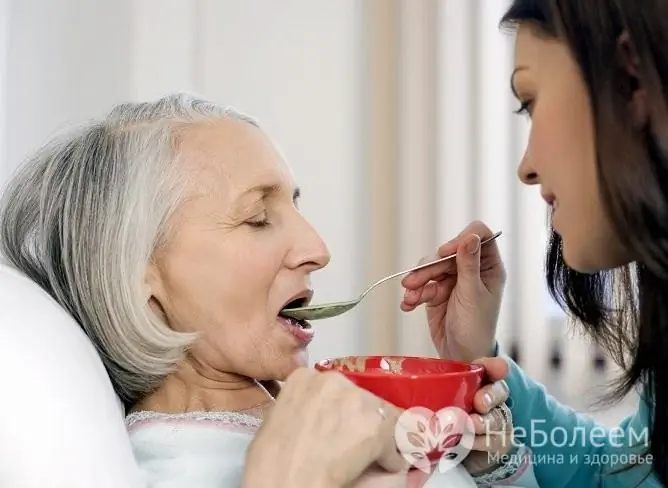
The diet for bedridden patients is developed by the attending physician, the diet should be light and nutritious
Proper nutrition for bedridden patients after a stroke is selected taking into account the body's needs for quick and effective rehabilitation, which largely determines the further prognosis. It should be light and nutritious.
In older people, after a stroke, depression often develops, and they may refuse to eat. You need to find an approach to such patients, close people and the attending physician can help with this. If it is impossible for the patient to take food after a stroke on his own (especially in the first days), the patient has to be fed with nutritional mixtures through a probe.
Nutritional rules for ischemic stroke and hemorrhagic stroke are similar - in both cases, diet number 10 is prescribed (table 10 according to Pevzner). Nutrition for ischemic stroke, which is predominantly of an atherosclerotic nature, also involves a significant restriction of animal fats in order to lower cholesterol levels. When compiling a menu for patients after hemorrhagic stroke in the early period, it is necessary to take into account the restriction in the use of liquid (no more than 1.5 liters per day) and salt.
Meal mode
After a stroke, a person is recommended fractional meals. This means that food must be taken in small portions and often, at approximately the same intervals - it is important to adhere to the regimen, that is, food intake at certain hours. This approach allows the body to extract the maximum nutrients from food, improve intestinal activity, avoid food overload and hunger, and for people with increased body weight - to normalize it.
The principle of fractional nutrition involves at least 5-6 meals: three main (breakfast, lunch, dinner) and 2-3 additional meals. The last meal of the day is taken no later than three hours before bedtime.
What can you eat after a stroke
The nutritional menu for a cerebral stroke should be balanced, it should contain complex carbohydrates, easily digestible proteins, and fats (mainly vegetable). The daily diet should contain a sufficient amount of fiber, which helps to normalize digestion and stool. A list of foods that are recommended for the recovery period after a stroke:
- porridge;
- vegetables and dishes from them;
- fruits, dried fruits;
- berries (especially blueberries, viburnum, cranberries);
- lean meat, fish, seafood;
- eggs (1 egg every 2 days);
- dairy and fermented milk products;
- vegetable oils for dressing dishes.
The amount of fluid consumed affects the rheological properties of the blood, therefore, it must be agreed with the attending physician.
What should be limited in the diet
Immediately after a stroke, it is necessary to stop using salt, later, after the patient's condition has stabilized, you can gradually introduce it into the diet, bringing it to 5 g per day, no more.
The following should be excluded from the diet:
- canned food, marinades and pickles;
- fatty, fried in oil, smoked dishes;
- strong meat and fish broths;
- sausages;
- mushrooms;
- cocoa and products from it;
- confectionery with fat content;
- mustard, horseradish, mayonnaise.
It is necessary to give up fast food, snacks and other "junk" food.
Alcohol is strictly prohibited. In the late recovery period, a small amount of natural dry red wine is allowed from alcohol, any other types of alcohol, including beer and cognac, are not allowed.
You can not use spices, especially hot and hot, vinegar, hot sauces. It is necessary to limit the consumption of sugar (no more than 50 g per day), while it should be remembered that the daily rate implies not only sugar in its pure form, but also its content in other products. With the development of a stroke against the background of diabetes mellitus, it is recommended to completely abandon sugar, replacing it with a small amount of natural honey or sweeteners, for example, stevia.
Diet after a stroke: table 10 according to Pevzner
The Diet Table 10 is designed to help improve the functioning of the cardiovascular system, kidneys, liver, therefore it is recommended for stroke patients.
Diet table 10 means avoiding food that is difficult to digest, reducing the total calorie content of foods, limiting foods that negatively affect the gastrointestinal tract, cardiovascular and nervous system. Fried, smoked, pickled and canned foods should be avoided. Food should be boiled, stewed, baked, or steamed.
The menu includes first courses (vegetable soups with and without cereals, lean borscht, beetroot soup), sour cream, lemon juice, and herbs are allowed. Bakery products must be made from flour of the first or second grade, it is recommended to eat dried bread, biscuit biscuits.
Eggs can be boiled soft-boiled, you can also make a protein omelet, baked or steamed omelet with herbs.
In the absence of individual intolerance, it is recommended to include milk in the daily menu; fermented milk products (kefir, yogurt, yogurt, fermented baked milk, cottage cheese) and dishes made from them are useful.

The diet of stroke patients is based on the basic principles of a healthy diet
Semolina is not recommended from cereals; it is allowed to include pasta in the diet.
Vegetables should be eaten both raw and thermally processed, as well as berries and fruits. From sweets, honey, natural jam, marmalade, marshmallows, caramel, candy, fruit jellies and mousses are acceptable.
From drinks, weak tea with lemon, natural juices, jelly and compotes from fresh fruits, dried fruits and berries, green and herbal tea are allowed. In the late recovery period, the use of natural coffee with milk is occasionally allowed.
Diet for patients after acute cerebrovascular accident is not a temporary measure. It is recommended to adhere to proper nutrition after a stroke constantly, to prevent relapse of acute cerebrovascular accident and other adverse consequences.
Video
We offer for viewing a video on the topic of the article.

Anna Aksenova Medical journalist About the author
Education: 2004-2007 "First Kiev Medical College" specialty "Laboratory Diagnostics".
Found a mistake in the text? Select it and press Ctrl + Enter.


